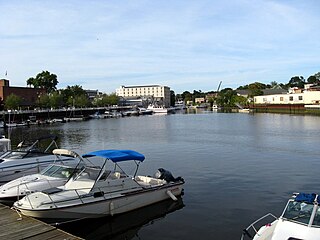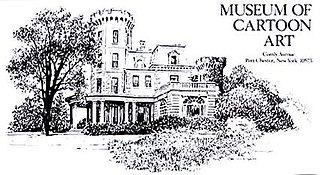Related Research Articles

Greenwich is a town in southwestern Fairfield County, Connecticut, United States. As of the 2020 census, it had a population of 63,518. It is the largest town on Connecticut's affluent Gold Coast. Greenwich is home to many hedge funds and financial services firms due to its residential setting and proximity to Manhattan.

Port Chester is a village in the U.S. state of New York and the largest part of the town of Rye in Westchester County by population. At the 2010 U.S. census, the village had a population of 28,967 and was the fifth-most populous village in New York State. In 2019, its population grew to a census-estimated 29,342 residents. Located in southeast Westchester, Port Chester forms part of the New York City metropolitan statistical area. Port Chester borders Connecticut and the town of Greenwich to the east. It is one of only 12 villages in New York still incorporated under a charter; other villages either incorporated or reincorporated under the provisions of Village Law.

Rye Brook is a village in Westchester County, New York, United States, within the town of Rye. The population was 9,347 at the 2010 census.

Rye is a town in Westchester County, New York, United States. The population was 49,613 at the 2020 United States census over 45,928 at the 2010 census. It is a separate municipality from the city of Rye. The Town of Rye contains two villages – Port Chester and Rye Brook – and the Rye Neck section of the village of Mamaroneck. Port Chester, Rye Brook and Rye Neck comprise the entire area of the town of Rye.

New Roc City, also known as New Rochelle Center, is an entertainment, retail and residential complex in the Downtown section of the city of New Rochelle in Westchester County, New York. It is located at 33 LeCount Place, between Main Street North and Main Street South. The center was built on the site of the former New Rochelle Mall, which closed in 1992.

Sheffield Ski Village was an artificial ski slope complex in the Parkwood Springs area of Sheffield, England which operated from 1988 until it was destroyed by fire in 2012. It was believed to be the largest artificial ski resort in Europe with a sports shop, bar, restaurant and a range of slopes which included a Snowflex nursery slope, a Dendix recreational slope and a freestyle park consisting of a half pipe, hip jump, kicker, a quarter pipe and various grind rails.

Byram is a neighborhood/section and census-designated place (CDP) in the town of Greenwich in Fairfield County, Connecticut, United States. It had a population of 4,146 at the 2010 census, and a census-estimated population of 4,216 in 2018. An endcap of Connecticut's Gold Coast, Byram is the southernmost point in the town of Greenwich and the U.S. state of Connecticut. It is separated from Port Chester, Westchester County, New York, by the Byram River. Byram was once known as East Port Chester.

New York State Route 120A (NY 120A) is a state highway in southern Westchester County, New York, in the United States. It serves as an alternate route to the southern half of NY 120 running along the New York–Connecticut state line. The southern terminus of the route is at NY 120 in Harrison. Its northern terminus is at NY 120 in North Castle. Most of the 8.55-mile (13.76 km) route straddles the New York–Connecticut state line, and part of the route is physically located in Connecticut. However, this part of the highway is not recognized by Connecticut as "Route 120A", and is considered to be part of NY 120A by the New York State Department of Transportation (NYSDOT).

Port Chester station is a commuter rail station on the Metro-North Railroad New Haven Line, located in Port Chester, New York. The station is the northernmost station on the line in New York before crossing into Connecticut. The station has two high-level side platforms, each 10 cars long, serving the outer tracks of the four-track Northeast Corridor.

The history of Greenwich, Connecticut, United States.

The Byram River is a 13.9-mile (22.4 km) long river spanning southeast New York state and southwestern Connecticut in the United States. It has a 29-square-mile (75 km2) drainage basin.

William Ryan was an American banker and businessman who served one term as a U.S. Representative from New York from 1893 1895.

The National Cartoon Museum was an American museum dedicated to the collection, preservation and exhibition of cartoons, comic strips and animation. It was the brainchild of Mort Walker, creator of Beetle Bailey. The museum opened in 1974, and went through several name changes, relocations, and temporary closures, before finally closing for good in 2002.

Pat's Hubba Hubba, also known as "Hubba's", was a late-night greasy spoon chili restaurant located at 24 North Main Street in the village of Port Chester in Westchester County, New York. Near the New York-Connecticut border, Hubba's catered to the local bar scene by staying open until 5:00 am on the weekends, and at least 3:00 am on weeknights.

The William E. Ward House, known locally as Ward's Castle, is located on Magnolia Drive, on the state line between Rye Brook, New York and Greenwich, Connecticut, United States. It is a reinforced concrete structure built in the 1870s.

The Japanese School of New York, also known as The Greenwich Japanese School (GJS), is a Japanese elementary and junior high school, located in Riverside, Greenwich, Connecticut, near New York City.
Carmel Academy was a Jewish private school in Greenwich, Connecticut, serving grades Kindergarten through 8. Also including transitional Kindergarten The school originally was located in Port Chester, New York.
George Atwood Slater was an American lawyer and politician from New York.

The New York and Stamford Railway was a streetcar line that connected the Westchester County suburbs of New Rochelle, Larchmont, Mamaroneck, Harrison, Rye, and Port Chester, with the Connecticut suburbs of Greenwich and Stamford. The company was formed in 1901 when the New York, New Haven and Hartford Railroad combined the Larchmont Horse Railway Company with the Port Chester Street Railroad Company. The Larchmont Horse Railway Company was founded in 1888 by the Larchmont Manor Company to construct a line from the New York, New Haven and Hartford Railroad Larchmont train station to its development 1.2 miles from town. The line was rebuilt for electric operation and extended to Harrison in 1901. The Port Chester Street Railroad opened in 1898 serving Port Chester, New York. The trolley line was soon extended west through Rye to Harrison in 1901. The two companies were merged that summer to form the New York and Stamford Railway. Trackage rights over the Westchester Electric Railroad were obtained for access to New Rochelle.
References
- 1 2 Berger, Joseph (July 1, 1999). "25 Years Later, Disco Fire Haunts Its Survivors". New York Times. Retrieved July 7, 2013.
- 1 2 3 Teichgraeber, Kathleen (July 1, 1974). "24 die in blaze at Gulliver's; D.A. launches full-scale probe". The Daily Item. Port Chester, New York. pp. 1, 12.
- ↑ blrggh, Super Elite KISS Fan (August 17, 2015). "Gulliver's Nightclub Picture". www.kissfaq.com. Retrieved January 31, 2024.
- ↑ "Fire crossed border?". The Daily Item. Port Chester, New York. July 1, 1974. p. 2.
- 1 2 3 4 5 6 7 8 Montgomery, Paul L. (July 1, 1974). "Terror-Stricken Throng Rushes for Narrow Stairway to Exit". New York Times.
- 1 2 Plunkett, R.B. Jr. (July 2, 1974). "Inspections late". The Daily Item. Port Chester, New York. pp. 1, 14.
- 1 2 3 r/KISS, ballbering71 (June 30, 2022). "Throwback Thursday: (06/30/74) Eric Carr (far left in photo) survives the Gulliver's nightclub fire, but two members of his band, Creation, do not - details in comments". www.reddit.com. Retrieved January 31, 2024.
{{cite web}}: CS1 maint: numeric names: authors list (link) - 1 2 3 Kelly, Tom (July 1, 1974). "Fire in N.Y. Discotheque Fatal to 24 Persons". Unknown newspaper. Associated Press. Retrieved July 7, 2013.
- ↑ Stanton, Sydney; Bissel, Elaine (July 1, 1974). "Band warned of fire". The Daily Item. Port Chester, New York. p. 3.
- ↑ Stevenson, H.L. (July 1, 1974). "New York Suburban 'Disco' Fire Kills 24 Merrymakers". Unknown Newspaper. United Press International. Retrieved July 7, 2013.
- 1 2 3 4 5 6 Special, Robert Lindsey (July 2, 1974). "Site of 24 Deaths Lacked A Fire Detection System". www.nytimes.com. Retrieved January 31, 2024.
- 1 2 3 4 lugnut, 2,000 Man, baby! (July 13, 2006). "Eric Carr in 'The Encyclopedia of Dead Rock Stars'". www.KissFAQ.com. Retrieved January 31, 2024.
{{cite web}}: CS1 maint: multiple names: authors list (link) CS1 maint: numeric names: authors list (link) - ↑ Berger, Joseph (July 1, 1999). "25 Years Later, Disco Fire Haunts Its Survivors". The New York Times. Retrieved September 6, 2019– via NYTimes.com.
- ↑ "Only teeth can tell ID". The Daily Item. Port Chester, New York. July 1, 1974. pp. 2B.
- 1 2 3 Greenhouse, Linda (July 3, 1974). "Inquiry Indicates Fire Fatal to 24 Started in Nursery". New York Times.
- 1 2 Moss, Brian (July 15, 1974). "N.Y., Conn. await report of surveyors". The Daily Item. Port Chester, New York. p. 1.
- ↑ Carmody, Deirdre (July 17, 1974). "Westchester to Charge Man With Murder in Bar Fire That Killed 24 on New York-Connecticut Border". New York Times.
- ↑ Moss, Brian (July 12, 1974). "Arson in Gulliver's tragedy?". The Daily Item. Port Chester, New York. pp. 1, 12.
- ↑ "Leonard charged with murder". The Daily Item. Port Chester, New York. July 16, 1974. p. 1.
- 1 2 3 4 Moss, Brian (July 16, 1974). "Snarl in fire check?". The Daily Item. Port Chester, New York. pp. 1, 10.
- ↑ "Greenwich Suspect Indicted in Deaths Of 24 at Gulliver's". New York Times. July 31, 1974.
- 1 2 "A Connecticut Man Gets 15-Year Term For Fire Killing 24". New York Times. July 17, 1975.
- ↑ Seigel, Max H. (July 20, 1977). "Appeals Court Upsets Conviction In Port Chester Fire Fatal to 24". New York Times.
- ↑ "Murder Guilt Ruled". The Spokesman-Review. Spokane, Washington. Associated Press. September 8, 1978. p. 12. Retrieved July 8, 2013.
- ↑ "Appeal Is Planned In Arson Murders". The New York Times. December 18, 1985. Retrieved July 8, 2013.
- 1 2 3 "Sentenced man to be freed". Record-Journal. Meriden, Connecticut. United Press International. April 10, 1986. p. 38. Retrieved July 8, 2013.
- 1 2 "Lawsuit looms in Gulliver's fire". The Daily Item. Port Chester, New York. July 6, 1974. p. 1.
- ↑ Moss, Brian (July 9, 1974). "Possible fire lawsuits spreading". The Daily Item. Port Chester, New York. p. 1.
- 1 2 3 Moss, Brian (July 10, 1974). "$12 million claim hits village". The Daily Item. Port Chester, New York. pp. 1, 12.